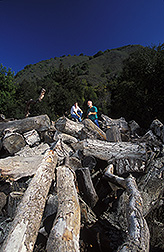This page has been archived and is being provided for reference purposes only. The page is no longer being updated, and therefore, links on the page may be invalid.
Read the magazine story to find out more. |
|
Plant Doctors Target Sudden Oak Death
By Marcia WoodFebruary 1, 2005
Majestic oaks and woody backyard plants like azaleas and camellias can both fall victim to a microbe that's perhaps best known for causing Sudden Oak Death disease in California woodlands. The fungus-like microorganism, Phytophthora ramorum, is the target of Agricultural Research Service scientists working in laboratories and greenhouses on both coasts.
These researchers are plant pathologists, or "plant doctors"—experts in plant diseases. They're working to uncover secrets about the microbe, and to create new, environmentally friendly ways to thwart it.
P. ramorum has menaced California's scenic oak woodlands since the mid-1990s. And, more than a half-million otherwise ready-to-sell nursery plants have had to be destroyed to ensure they wouldn't spread the infection.
Agricultural inspectors and plant nursery operators checking their stock for the microbe might soon have additional help from a laboratory test developed by ARS plant pathologists Frank N. Martin at Salinas, Calif., and colleague Paul W. Tooley at Ft. Detrick, Md. Their assay is based on a stretch of mitochondrial DNA—telltale genetic material that occurs outside of a cell's nucleus, according to Tooley.
The assay may complement the tests of the pathogen's nuclear DNA that are already in use, Martin noted.
Fast, reliable assays help technicians in plant-health laboratories across the county determine if the microbe in plant samples they're examining is—or isn't—P. ramorum.
Martin, who's based in the ARS Crop Improvement and Protection Research Unit, and Tooley, in the agency's Foreign Disease-Weed Science Research Unit, developed the test with Cheryl L. Blomquist, a State of California plant pathologist.
Colleague Robert G. Linderman at Corvallis, Ore., is probing the differing effects of P. ramorum on woody ornamental plants popularly grown in West Coast nurseries, and is looking for new tactics nursery managers could use to undermine the pathogen. A plant pathologist, Linderman is in the ARS Horticultural Crops Research Unit.
Read more in the February issue of Agricultural Research magazine.
ARS is the U.S. Department of Agriculture's chief scientific research agency.

